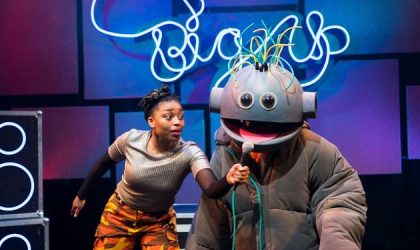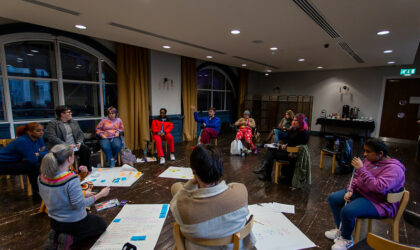
Beginner Read Digital Strategy
An effective digital strategy can be vital to your organisation’s success. Read on to understand the key considerations when developing yours.
In this article

Stopgap Dance Company: Frock, 2019, Photo @ Chris Parkes
Personas are composite sketches (fictional representations) of people within your audience or customer base. They are a means of bringing to life the people who are engaging with you, adding flesh and bones to a representative picture of a member of that group. It is a way of more actively visualising your audience/customers, helping your marketing and strategy because you and your team can use them to understand motivations and anticipate needs in your marketing and communications more fully.
Personas work hand in hand with segmentation of your target audiences, in which you create groups to target, based on common characteristics within that group. Personas are created through quantitative (numbers-based) and qualitative (descriptive language-based) data. If you have limited data, you can still create personas and modify them over time.
In this article, we explore how personas work where resources in terms of time and budgets are limited. I have been involved in a number of projects where agencies have helped to create personas, but if you don’t have time or money for a major project, what could a lo-fi, low-cost version of personas look like and how can creating personas add value? Can you still benefit from creating personas with incomplete data?
Key reasons to use personas are:
If you aren’t using personas at the moment, it’s a good idea to start by creating a tactical persona for your high-value or priority segments. For example, family audiences are often a key segment, where audiences will have characteristics and specific needs. Your members/patrons/frequent customers/attenders segment is a core part of your business so creating a persona for this high-value segment could help to support getting people back again (retention).
Tactical personas can also help if you are looking to develop new initiatives or projects. For example, developing a persona for a scheme to target first-time attendees can help inform the campaign choice of channels, content creation, user journey, and messaging. You can use our handy persona checklist which suggests ways in which personas could work across all activities.
A persona is a composite sketches (fictional representations) that communicates the primary characteristics of a group of users, identified and selected as a key target through use of segmentation data.
The idea of a composite sketch means that they are not one person, but rather based on identifying characteristics that represent the majority of people in that segment.
Creating relevant personas helps you to understand who your customers are and what their motivations are. In turn, this enables you to tailor your messaging, content, and customer experience to them.
Personas are valuable if you can use them as part of your decision-making processes, considering them right at the outset of each marketing campaign. Your marketing campaigns should seek to speak to at least one of your key personas.
Personas can help you to be consistent – with your persona in mind, creating messaging and experiences for them becomes easier across the team. Personas can aid the process of putting yourself in somebody else’s shoes, identifying pinch points, and anticipating the needs of a particular target audience.
42% more visitors convert from personalised call to actions (HubSpot)
But don’t personas work against audience development and exclude people who don’t fit the segment profile? In fact, the task of creating a persona based on evidence, helps to focus effort and avoid unconscious bias whereby the persona we normally work with in mind is often someone quite like us.
I liked this summary from HubSpot:
In building personas it’s helpful to leave gaps rather than make too many assumptions, and to see if over time you might be able to collate the data needed. So, what data could you start with and what may already exist?
CRM and ticketing histories are wonderful resources if you have them, but insight and data to build your personas can come from other sources:

Example of Facebook Audience Insights, Hootsuite
Sample questions to create persona
Consider incorporating questions and data gathered in all your communications at all stages of the customer journey. Here is an example from an email from Greenpeace which is informing their persona profiling and segmentation:

There’s external data that may be useful:
Fundamental info for your personas:


Personas can change over time as you gather more information – if you don’t have the data you need, how could you collect it?
Once you get started with personas, here is a checklist on how personas could be part of your decision-making.
Persona checklist
One final consideration is that personas can help you to articulate your target audience more fully and inspire you to reach out to new partners. A persona can give an instant picture to a potential partner enabling you to collaborate with other individuals and organisations, aligning yourself with them to create synergy, kudos or increase reach.
The Digital Culture Network is here to support you and your organisation. Our Tech Champions can provide free 1-2-1 support to all arts and cultural organisations and individuals who are in receipt of, or eligible for, Arts Council England funding. If you need help or would like to chat with us about any of the advice we have covered above, please get in touch. Sign up to our newsletter below and follow us on Twitter @ace_dcn for the latest updates.
Beginner Read Digital Strategy
An effective digital strategy can be vital to your organisation’s success. Read on to understand the key considerations when developing yours.
Beginner Read Digital Marketing
Five recommendations to help improve your digital marketing performance.
Beginner Read Social Media
Social media is a unique and powerful way to help your organisation thrive and engage with your audience. Read on to find out more.
Beginner Read Email Marketing
When your email marketing campaign doesn’t perform as well as you need it to there are some simple questions to ask. This article gives you the 5 W’s to investigate why your campaign is not performing as expected: Who, What, When Where, and Why?
Beginner Read Email Marketing
Contact data is business critical and one of your organisation's most valuable assets. Find out how to set up and grow, and collect a contact database starting with these 5 essentials.
Beginner Read Email Marketing
Want to improve your email marketing? Our health check will help you asses and improve you activities.




